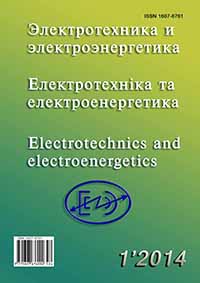INFLUENCE OF THE ELECTRODES BLANKS LOCATION ON THE ELECTRIC HEATING POWER DISTRIBUTION IN THE ACHESON FURNACES CORE
DOI:
https://doi.org/10.15588/1607-6761-2014-1-1Keywords:
mathematical model, electromagnetic field, the thermoelectric field, Acheson furnace, direct current, alternating current, electrodes blanks, thermal powerAbstract
The modeling of electromagnetic and thermoelectric processes on the basis of numerical realization by finite element method of the generalized three-dimensional models of DC and AC graphitization is proposed.The features of furnace structure and side busbar packages, spatial arrangement of the electrodes blanks in the conductive backfill of core, temperature dependence of the electromagnetic and thermal properties of materials, technological regimes of graphitization are taken into account. The high accuracy and efficiency of numerical implementation are provided.
The character and regularities of the spatial distribution of specific thermal power in the core at the vertical and horizontal location of the electrode blanks in the core are defined.
It is revealed that the specific electric resistance of the core is determined by the ratio of specific electric resistance of electrode blanks, backfill materials, shunt layers and don’t practically depend on the orientation of the electrodes blanks in the Acheson furnace.
It is found that in vertical stacking of blanks in the Acheson furnace core at diametric section blanks more heating capacity is allocated compared with the horizontal transverse stacking. Intensification of the heating, reduction in the duration the campaign and energy are provided
References
Кузнецов Д. М. Процесс графитации углеродных материалов. Современные методы исследования [Текст] / Д. М. Кузнецов, В. П. Фокин. – Новочеркасск : ЮРГТУ, 2001. – 132 с.
Кузнецов Д. М. Графитация крупногабаритных электродов. Процесс Ачесона [Текст] / Д. М. Кузнецов. – Ростов н/Д: РГАСХМ ГОУ, 2003. – 168 с.
Цветков Ф. Ф. Тепломассообмен: Учебное пособие для вузов. – 2-е изд., испр. и доп. [Текст] / Ф. Ф. Цветков, Б. А. Григорьев. – М. : Издательство МЭИ, 2005. – 550 с.
Дрешпак Н. С. Результаты анализа режимов индукционного нагрева разъемных деталей машин [Текст] / Н. С. Дрешпак // Научный вестник НГУ. – 2012. – № 4. – С. 108–113.
Ярымбаш Д. С. Особенности определения параметров электрической схемы замещения печной петли печи графитации переменного тока [Текст] / Д. С. Ярымбаш, И. М. Килимник, С. Т. Ярымбаш // Електротехніка та електроенергетика. – 2010. – № 2. – С. 36–43.
Коржик М. В. Дослідження бічного шунта печі графітації [Текст] / М. В. Коржик, Г. І. Гурчик // Восточно-европейский журнал передовых технологий. – Харьков : Технологический центр, 2012. – №3/5 (57). – С. 39–43.
Буль О. Б. Методы расчета магнитных систем электрических аппаратов : Магнитные цепи, поля и программа FEMM: Учеб.пособие для студентов высш. учеб. заведений [Текст] / О. Б. Буль. – М. : Издательский центр «Академия», 2005. – 336 с. 8. Ярымбаш Д. С. Идентификация электрических параметров печной петли мощных печей графитации [Текст] / Д. С. Ярымбаш // Электротехника и электромеханика. – 2012. – №1. – С. 49–54.
Ярымбаш Д. С. Особенности контроля электрических параметров, мощности и энергопотребления во время кампании графитации в печи переменного тока [Текст] / Д. С. Ярымбаш, С. Т. Ярымбаш, О. В. Тютюнник // Вісник Кременчуцького державного політехнічного університету. – Кременчук : КДПУ, 2006. – Вип. 3/2006(38). – С. 53–55.
Ярымбаш Д.С. Особенности моделирования электромагнитных процессов в индукторе калибра мундштука пресса / Д.С. Ярымбаш, И.М. Килимник // Вісник Кременчуцького державного політехнічного університету – Кременчук, КДПУ, 2007. – №4(45) Частина 1. – С. 53 – 55.
Downloads
How to Cite
Issue
Section
License
Copyright (c) 2017 D. S. Yarymbash

This work is licensed under a Creative Commons Attribution 4.0 International License.
Creative Commons Licensing Notifications in the Copyright Notices
Authors who publish with this journal agree to the following terms:
Authors retain copyright and grant the journal right of first publication with the work simultaneously licensed under aCreative Commons Attribution License that allows others to share the work with an acknowledgement of the work's authorship and initial publication in this journal.
Authors are able to enter into separate, additional contractual arrangements for the non-exclusive distribution of the journal's published version of the work (e.g., post it to an institutional repository or publish it in a book), with an acknowledgement of its initial publication in this journal.
Authors are permitted and encouraged to post their work online (e.g., in institutional repositories or on their website) prior to and during the submission process, as it can lead to productive exchanges, as well as earlier and greater citation of published work.

